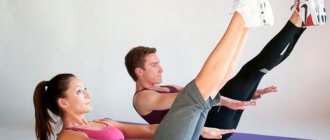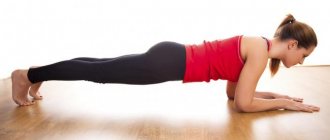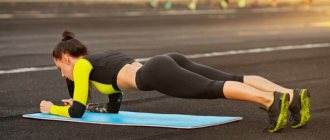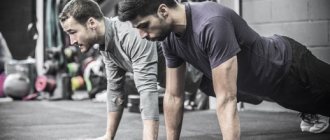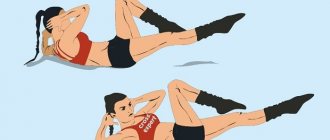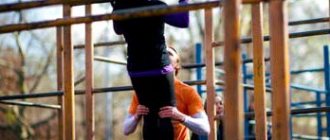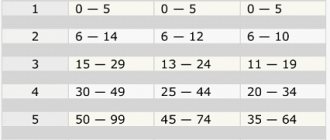The pose, which has been used by yoga enthusiasts for years, has gained widespread attention due to its number of benefits.
However, you do not have to attend special classes in order to complete the exercise. One of the simplest poses requires no flexibility or strength.
The changes you will notice after doing it daily are truly amazing. All you need is a wall.
Legs up pose
This exercise can be done both during the day and in the evening at any time when you want to relax or relieve fatigue, and before bed to fall asleep easier.
To perform the exercise, you need to lie as close to the wall as possible, being on a flat surface of the bed or a rug on the floor so that you feel comfortable.
- Raise your legs and place them as close to the wall as possible so that they were at an angle of 90 degrees
. Your knees should be straight and your head should be on the floor or bed.
- Shoulders and hips are at the same level. Relax your shoulders
, do not press them to your ears, and keep your hands loose at your sides, palms up or down.
- If you feel tension in your neck, place a towel roll or small pillow under your head. Also, many people put a pillow or cushion under the lower back or buttocks
. Find the position that is most comfortable for you.
- Relax
. Just lie down and breathe deeply, stretching your inhalations and exhalations. You can check to see if there are any tightness or tension in your body and release them. Feel the weight lifting from your legs.
- Are you in this position? from 5 to 20 minutes
at your own discretion.
To come out of the pose, bring your knees to your chest, turn onto your right side and lie down, taking a few deep breaths. Using your legs and arms to push, stand up or, if you are doing this before bed, just go to bed.
As was said, this position has a positive therapeutic effect.
Here are 7 reasons why you should do this exercise every day.
Muscles rest and energy returns
When you raise your legs, you tighten the muscles and tendons of the thigh and lower leg. Gravity, while you lie upside down, tones your muscles as if you were tensing them while doing light exercise. But this is not the only benefit of this position.
To keep our body upright, four muscle groups tense throughout the day:
- The first group
is the muscles of the back of the thigh, which extend the ankle joint. - The second group
is the muscles of the anterior thigh that extend the knee joint. - The third group
is the muscles of the pelvis and lower back, which keep the hip joint straight. - The fourth group
is the erector spinae muscles.
You do not feel the work of these muscles, but the feeling of weakness in the evening is due to the fact that acidic substances have accumulated in the muscle tissue. To normalize the acid-base balance, muscles secrete lactate, a salt of lactic acid. Despite the popular belief that lactate is harmful, a 2016 study at the University of California showed that muscles can reuse it as an energy source if it is reduced in the liver to glucose and returned as one of its breakdown products back to the muscles with blood. Read more about the study by following the link in the bibliography. But for lactate to turn into glucose, it must enter the blood, reach the liver and return back to the muscles. You can speed up the process of flushing lactate from your muscles by lying with your feet up. Firstly, this way you will relax your muscles, and secondly, it will facilitate the outflow of blood.
Interesting fact!
Lactate is formed in the muscles, even if you have not experienced any stress, but, for example, just sat in an office chair all day.
Calms the nervous system and restores brain function
By redistributing blood flow in an inverted position, you direct more blood, oxygen and glucose to the brain. This can solve several problems at once - eliminate headaches, cure insomnia and eliminate nervous tension. This position also “trains” the nervous system, restoring its ability to quickly regulate blood pressure and even improves memory.
Important!
If you have high intracranial pressure, you should not lie in this position.
Interesting fact!
Inversion therapy is practiced by many famous people. For example, actor Jackie Chan and author of the novel “The Da Vinci Code” Dan Brown. According to the latter, the inverted position helps him “regain clarity of mind.”
Lymphatic drainage is carried out
For lymphatic drainage, it is not necessary to sign up for an expensive procedure at a beauty salon. Lying on your back with your legs raised can significantly help the lymphatic system of the lower extremities in removing excess tissue fluid - lymph. Lymph is 96% water, so even with a healthy venous system, your legs may swell due to lymph stagnation. Despite the fact that lymphatic vessels are very similar in structure to veins, and they also have valves, they are almost devoid of elasticity, and therefore the pressure in them is lower than in the veins. All this means one thing - no elastic bandages or tights will help you cleanse the lymph. But this can be done by simply raising your legs up.
There is a significant difference between lymphatic and venous edema. If during normal swelling your tissues are simply compressed by excess “water,” then when lymph stagnates, cleansing does not occur in them. The lymphatic system of the legs needs a temporary “rest from gravity”. With poor lymphatic drainage, about 83% of toxic products accumulate in the fluid that surrounds the cells. Lymph that is not filtered in time contains toxins, cell waste products, harmful microbes and even cancer cells. This condition is called lymphotoxicosis.
Important!
This method can facilitate lymphatic drainage only if the stagnation is bilateral. If you only have swelling in one limb, you should see a doctor immediately.
Interesting fact!
When lymph stagnates, tissues do not receive the substances they need, the delivery of which is carried out not with the blood, but through the lymph. For example, lipids are absorbed from the intestine not into the blood, but into the lymphatic vessels. The protein that comes from the blood into the tissues returns back to the bloodstream through the lymph, so when lymph stagnates, a low protein content is detected in a blood test.
Reduces pain during menstruation
Experts disagree on this issue. Some argue that such poses during menstruation are absolutely safe and even beneficial, because they relieve muscle spasms and calm the nervous system. But on the other hand, due to increased blood flow in the pelvic organs, you may lose more blood. Many doctors and even yoga experts do not recommend doing such exercises on “critical days.” There is a possibility that menstrual blood will partially flow in the opposite direction and enter the abdominal cavity through the fallopian tubes.
This development mechanism is attributed to endometriosis, a disease in which pieces of the uterine lining get onto the ovaries, peritoneum, rectum or bladder, and then become fixed to their walls. With each menstruation, these, so to speak, “implants” bleed. But this is possible if you don’t just raise your legs up, but complicate the task by lifting your entire torso.
Execution technique
Initial position
- Lie face down on the floor, on a thick rubber mat, two regular yoga mats or 1 Pilates mat;
- Place your forehead on your palms folded in front of you;
- Tighten your stomach by 30 percent, tense your upper back, move your shoulder blades away from your ears, lower them to your pelvis;
- Touch the floor with your ankle and pull your toes back.
Movement
- Lift your hips off the floor by tensing your buttock muscles;
- At the same time, tighten your stomach a little more and, as it were, press the anterior abdominal wall into yourself;
- Raise your hips to a height until your lower back remains comfortable;
- Return to starting position;
- The tempo of execution is slow, raising the hips for several counts, and also lowering them.
Attention
- First, the ankle should come off the floor, and only then the hips;
- Swinging is not allowed;
- The body can either be raised, resting on the forearms, or left on the floor. Each person seeks a comfortable position based on their anthropometry.
The heart is unloaded
With a significant load on the lower extremities, a large volume of blood enters them. The heart is forced to pump blood under high pressure in order to deliver it to all tissues. Consequently, in order to provide the required volume of blood under increased load, the heart is forced to contract more often. When we lie with our legs raised up, the heart muscle rests. Blood flow to the heart increases, and between contractions the chambers of the heart are filled with more of it. The more the myocardium stretches during filling, the stronger the heart muscle contracts. Therefore, in the “legs up” position, your pulse slows down. This position is especially useful for people prone to low blood pressure and headaches.
However, if you have been diagnosed with heart failure, arterial hypertension and arrhythmia, it is better not to practice this exercise. The effect may be the opposite - you will experience an attack of palpitations and shortness of breath. People with serious heart pathology are recommended to lie with the head end of the bed elevated.
Improves appearance
By regularly doing this exercise, you can improve the condition of your skin and hair, slow down the appearance of gray hair, and even tighten your facial muscles. Doctors explain the anti-aging effect by improving blood flow in the upper parts of the body, improving metabolism in the body and the calming effect of this position.
Interesting fact!
The “legs up” position gained its popularity after the massive spread of yoga, where it was known as “Viparita Karani”. In Sanskrit it means "upside down, but in action." According to Eastern teachings, this pose bestows youth by directing all vertical flows in the opposite direction. This is a completely natural state for our body. Remember that a healthy baby spends almost all of his time lying down, and if he is not swaddled, you can notice how he lifts his legs up.
Reduces fat around the waist
It's hard to imagine that simply lying on your back with your legs stretched up will help you lose excess fat around your waist. But experts in the field of oriental medicine are convinced that fat accumulates where blood circulation is poor and toxins accumulate. Western evidence-based medicine confirms that with poor blood circulation, oxidative stress develops in the vessels. At the same time, harmful oxygen radicals destroy cells and maintain low-grade inflammation.
If your waist has increased due to internal fat in the abdominal cavity, when you raise your legs up, you disperse blood through the internal organs. This improves their function and restores mobility. As a result, metabolism improves and toxins are removed in time. The fat layer also receives its share of blood and stops releasing free radicals. Also, by helping the body fight obesity in the waist area, you significantly reduce the risk of developing type 2 diabetes.
Interesting fact!
If the fat layer does not receive enough blood, the body redistributes the blood flow so that there is enough for the fat cells, but because of this, other organs suffer. The more fat, the less organs receive blood, and the more substances are produced in the body that cause vasospasm and the production of oxygen radicals.
How to start a weight loss program?
When nutritionists say that you can lose weight even if you are obese, they are not lying, but it is not enough to set a goal, it is important to think about the way to achieve it. Excess weight is a consequence of improper functioning of the body.
or
failure to maintain energy balance
. Many people think that they can get in shape by switching to proper nutrition and starting to exercise. On the one hand, these are important and even necessary steps, on the other hand, the psychological component is also important, as well as correctly set goals and priorities.
First you need to get ready to work and not expect quick and dizzying results. If, after regularly overeating, you suddenly refuse to eat, it will be a huge stress for the body. When you “break down” or decide to stop the experiment, the body will quickly “work on mistakes” and make additional reserves in case hunger recurs. That is why people who thoughtlessly resort to strict diets often quickly gain back the lost kilograms “with interest.”
You need to lose weight gradually. Depending on your initial weight, it will be enough to lose no more than 3-5 kilograms per month.
. Such changes will take place without any special consequences, since the body will rebuild slowly.
